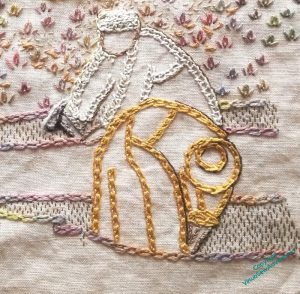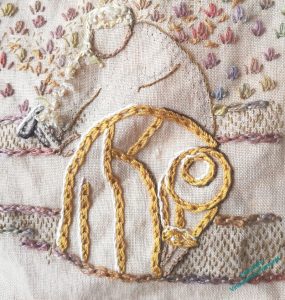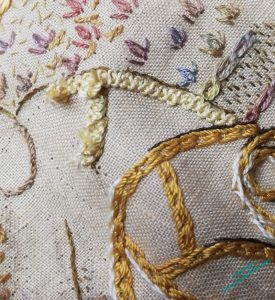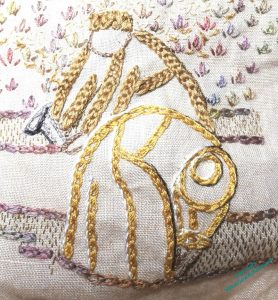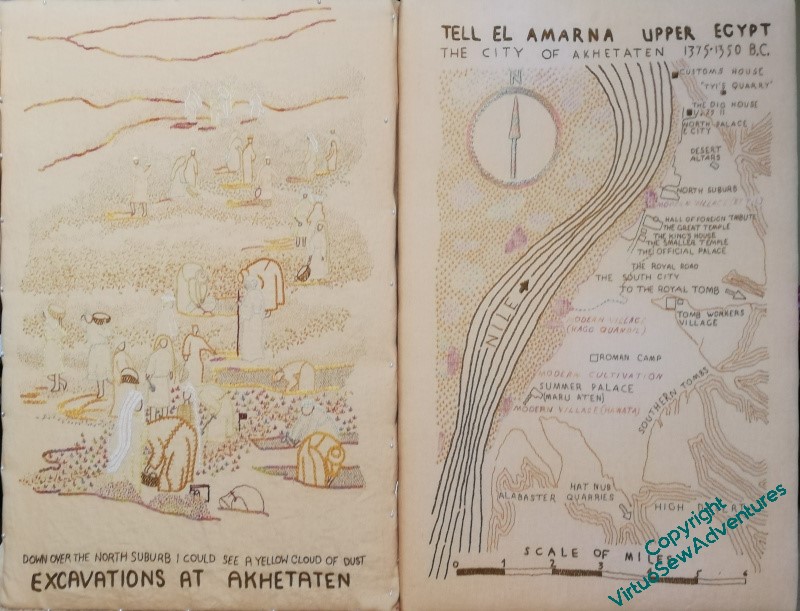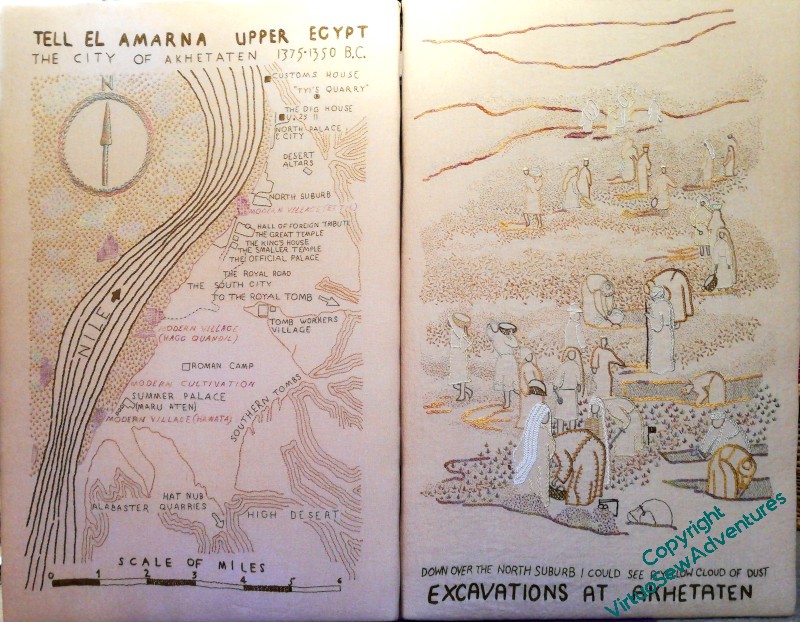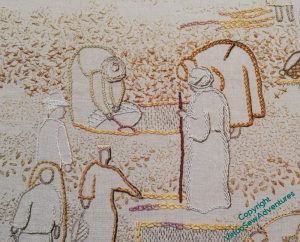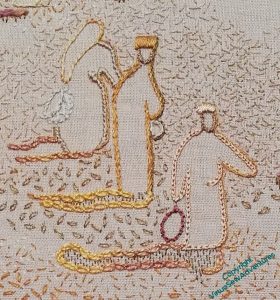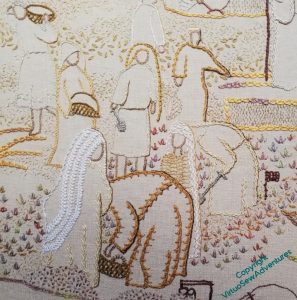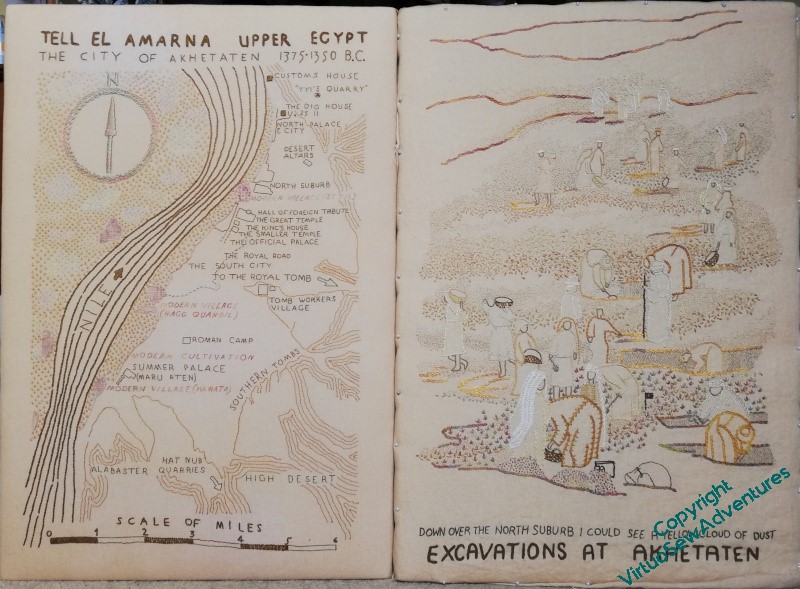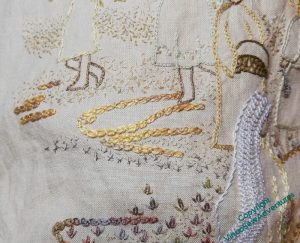Tag: Much to think about
Difficulties With The Staff
I’ve been a bit bothered about this pair of workmen ever since I finished them. The pale stone coloured thead is a bit too close to the background colour, and the squarish stitch looks too spiky, too contorted, and very uncomfortable.
What’s more, no matter what highlight and shadow I have added, I’ve not liked it more. So while I’ve been working on sunlight and shadows, I’ve been thinking about it.
Out it has come, and good riddance!
However…
With what should it be replaced? Clearly not Braid Stitch/Cable Plait Stitch (depending on which dictionary you have beside you!) in pale yellow. Only about half of the workman was reinstated before being swiftly removed.
Well, the decision was swift – the action, rather less so!
Fortunately all that playing and wrestling with it brought something else to my mind.
Hungarian Braided Chain is an old favourite, and I had been dismissing it because I’d already used it, but in one of the finer threads. Here in undivided stranded cotton, it has enough authority to back up the Shell Chain of the workman in front, and the slightly darker shade of gold helps too.
I think I’m happier now…
Continuing to think about display ordering..
You may recall that I wondered whether I should reverse the order I had planned for these two main panels of the Dreams of Amarna.
When I finally add the border panels and the “spots”, my intention as far as possible to have the spots that were already known set with the Map, and the spots which are more closely linked with Mary’s experiences at the dig set alongside the View of the Excavation. I’m still not sure which way around to put them, but perhaps if I can arrange the border panels to be moveable, we can change that depending on what else is in the exhibition? There was a suggestion, pre-Covid, that particularly northern British museums associated with the EES might be interesting in combining my embroideries with their finds. Now that’s an enticing thought…
I don’t think I’ve quite finished adding details, and I still need to think out my reasoning and placement for these two, but although the extra shadows are barely visible, even in person, they have, I think, brought a better sense of focus. I do, however, have a few highlights and details to add!
One thing I really like is the clear, un-seed-stitched section at the bottom. When the fabric is washed and ironed, I think that area of plain cloth above the title and surtitle will help to make everything settle together.
Adding more detail..
I started by tacking a shadow line along the edge of the Gufti with the staff, decided that it did indeed help, took out the tacking stitches, and started adding very fine stem stitch shadows in single strands of cotton or silk along the right hand sides of the figures.
I used different shades , and different levels of detail – I want the archaeologist in his pith helmet to remain only semi visible. He’s clearly consulting with the Gufti, but he’s not the focus of the flurry, he’s part of the pattern.
The middle distance figures gave me a little trouble, as the colours seemed a more emphatic, close to, than I remembered.
I’m looking across the room at them now, however, and they have settled back into place, just the slight thickening and darkening at the edge helping to make sense of the pattern that’s developing. Even the slightly darker basket, which I had doubts about when I’d stitched it, doesn’t unbalance the whole view.
In this bit of foreground, you can see that I have been varying the amount of detail I shadow. Some of these figures may get a little more detail, to bring them forward even more.
I’m even wondering about putting a shadow on the edge of the creamy white veil the foremost figure is wearing.
More to do, more to think about..
Having finished the title text and got to a point with the seeding where I think it is more or less complete, I pinned up the View of the Excavation over the lovely frame prepared for it, and then set it beside the Map, sat back, and stared thoughtfully.
I think the conversation is beginning to happen, now. There are still a few infelicities – the area at the far right where the tete de boeuf stitch falls away from the trench, and the area above it where there’s a sort of funnel shape between the areas of seed stitches. I think, too, that in the far distance, the seed stitching maybe tracks the shapes of the people a little too closely, and I need to make the edges a bit wispier.
When summoned to act as Cardboard Programmer, or Rubber Duck(!), The Australian said that he was having a hard time making out some of the people, and could I put a very narrow shadow that would balance pulling them out of the scene with not emphasising them to the point of obliterating the dust?
And then I had another thought. I have always put them in this order: Map on the left, whatever else I was going to do on the right. Should I keep to that, or should I change my mind?
Developments on the View of the Excavation
I love my worklight. It gives a wonderfully crisp and bright light to work from, and it can even be useful in bright daylight because it washes out deep shadows that confuse the eye. By and large, it also gives a better idea of true colour than the earlier one I had, which didn’t have the “throw” to reach from my side table to my hands, and tended towards the blue.
However, just every now and again, it doesn’t quite hit the nail on the head, as it were, and this is a case in point. That row of Knotted Cross stitch is plainly in too cold a colour for the surrounding stitches, and yet when I was picking the colour, using my worklight, the thread looked good, a warm darkish olive-brown. When I looked at the stitches having completed them, it looked much colder, just plain Wrong. Out it comes!
I tend only to unpick first thing in the morning, so rather than continue with the seeding, I went back at that point to the title stitching. And it’s finished!
It’s not entirely even, but neither was the stitching on the Map, and I like the unevenness. It recalls the unevenness of the ground, particularly as the dig advances across the area, and it is just the right weight to anchor the picture.
Working on this section has reminded me of just how much I enjoy working on embroidery in the hand. As I work on William, or on goldwork pieces, or even canvaswork, all of them in a frame with fabric held taut, there is something that I miss about holding the fabric in my hand, taking my stitches and wrapping my threads. I think I need to make sure, for the future, that I have a suitable “in the hand” piece on hand, as it were, to keep me connected to my first love of stitching – the stitches themselves.

